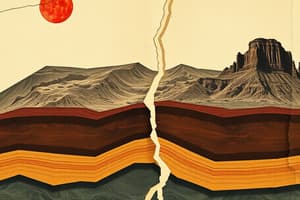Podcast
Questions and Answers
What happens at divergent plate boundaries?
What happens at divergent plate boundaries?
- Plates slide past each other
- Plates push toward each other
- Plates move away from each other (correct)
- One plate sinks under another
What is a characteristic of convergent plate boundaries?
What is a characteristic of convergent plate boundaries?
- Plates slide apart
- One plate sinks beneath another (correct)
- Only oceanic plates are involved
- Plates move in the same direction
Which of the following describes a transform plate boundary?
Which of the following describes a transform plate boundary?
- Plates collide to form mountains
- Plates move away from each other
- Plates slide along beside each other (correct)
- One plate sinks beneath another
What geological feature is often formed by convergent plates pushing against each other?
What geological feature is often formed by convergent plates pushing against each other?
What type of plate boundary involves subduction?
What type of plate boundary involves subduction?
Which component is found beneath the lithosphere?
Which component is found beneath the lithosphere?
What is the result of two plates converging at a subduction zone?
What is the result of two plates converging at a subduction zone?
What is the outermost layer of the Earth called?
What is the outermost layer of the Earth called?
What happens to a denser plate when it converges with a less dense plate?
What happens to a denser plate when it converges with a less dense plate?
Which of the following features is associated with divergent plate boundaries?
Which of the following features is associated with divergent plate boundaries?
Flashcards are hidden until you start studying
Study Notes
Plate Tectonics Overview
- The lithosphere, Earth's outermost layer, is divided into separate sections called tectonic plates.
Types of Plate Boundaries
- Convergent Boundaries: Plates move towards each other.
- Divergent Boundaries: Plates move away from each other.
- Transform Boundaries: Plates slide past one another in opposite directions.
Movement and Activity of Plates
- Divergent Plates: Two plates separate, creating new crust as magma rises.
- Convergent Plates:
- Subduction Zones: One plate is forced under another, sinking into the mantle.
- Plates colliding can lead to mountain formation through upward movement.
- Transform Plates: Plates slide along each other, often causing earthquakes.
Converging Plate Boundaries
- Subduction occurs when a denser plate sinks beneath a lighter plate.
- Transform boundaries involve lateral sliding of plates without significant vertical movement.
Geological Features
- Continental Crust: Thick, buoyant crust forming continents.
- Ancient Oceanic Crust: Thinner crust forming ocean floors.
- Lithosphere: Rigid outer layer of Earth comprised of continental and oceanic crust.
- Asthenosphere: Semi-fluid layer below the lithosphere that allows for plate movement.
Key Terms
- Mantle: The layer beneath the lithosphere where subduction occurs.
- Mountain Ranges: Formed due to convergent plate interactions and upward thrust from colliding plates.
Diagram Insights
- A cross-section of the Earth typically illustrates layers including ancient oceanic crust, lithosphere, and the formation of geological structures like mountain ranges.
Studying That Suits You
Use AI to generate personalized quizzes and flashcards to suit your learning preferences.




